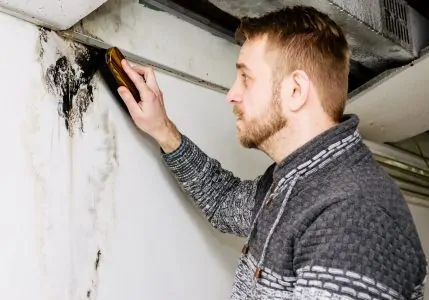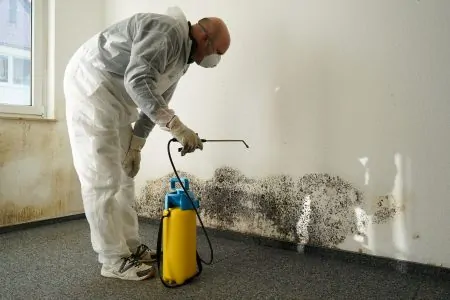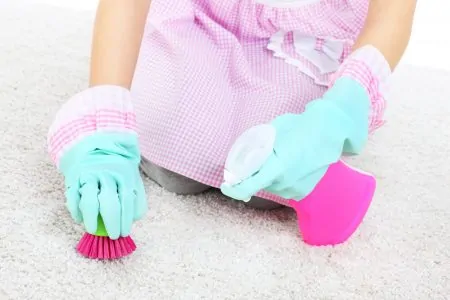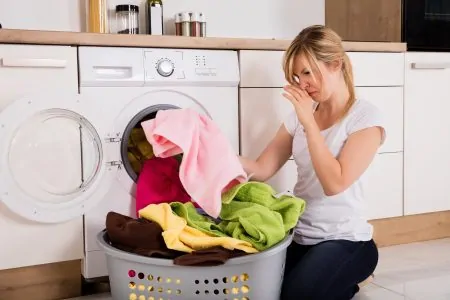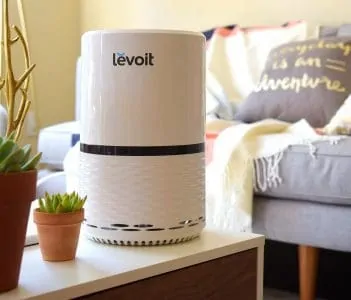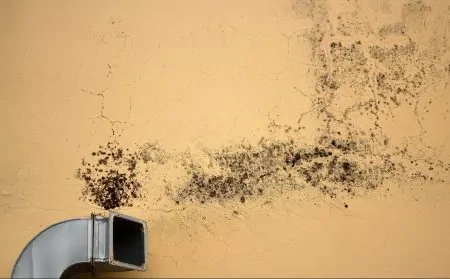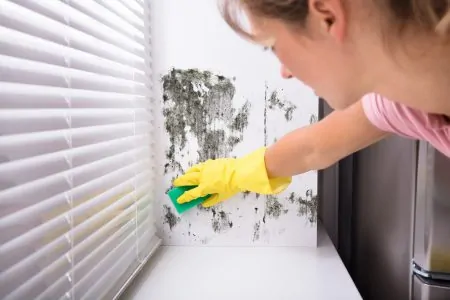The worst has happened: you’ve found a suspicious patch growing in your basement. Perhaps you haven’t been down there in a while. Maybe the mold took hold in a hidden area and spread insidiously over time.
Whatever the reason, you now have a potentially dangerous problem on your hands. Mold can provoke a host of nasty symptoms, from sneezing and coughing to infections.
Don’t panic — we’ll share how to get rid of mold in basements. If you’re not prepared or informed, you could worsen the situation or endanger your health.
Key Takeaways
- Mold grows in basements due to moisture, often caused by flooding, water leaks, or high humidity.
- Identify mold by comparing its appearance to common types, such as Aspergillus, Stachybotrys, and Penicillium.
- Test for mold using air, surface, or bulk methods to determine the species and extent of the issue.
- Remove mold using products like mold removers, bleach, borax, or essential oils, and avoid DIY chemical mixes.
Causes of Mold in the Basement
Understanding how and why mold found its way into your basement is vital. You don’t want to waste time getting rid of it only for it to reoccur.
Let’s briefly delve into the science behind mold. Your unwanted home invader is the result of fungi species that generate spores to reproduce.
When these teeny-tiny spores, invisible to the naked eye, land on something wet, they start to grow. There’s no way for mold to thrive and survive without moisture (1).
Now that you’re versed in mold 101, you can likely anticipate what the causes would be. These are the reasons why your basement could have been affected:
- After flooding: A flooded basement is an optimal environment for mold. Standing water and damp items such as furniture and carpets can serve as breeding grounds.
- Water leaks: As with post-flood moisture, leaky pipes, appliances, or drains in your basement will increase your risk of finding a moldy surprise.
- High humidity: If the old stereotype of your basement as a damp and dank place applies, your chances of mold will be higher. Humidifiers, air vents, and similar steamy gadgets or mechanisms can all encourage mold.
How to Identify Mold in Your Basement
The first step to victory is knowing your enemy. Certain mold colonies can be more hazardous to your health than others, and might best be left to the professionals.
As tens of thousands of fungi species can beget mold spores, we’ve narrowed it down to the most likely culprits (2). Compare your mold to these 12 common genera of fungi:
1. Acremonium
Acremonium ranges from whitish-grey to pink, with a cottony or velvety appearance. Several species are known to cause infections in humans and animals.
You’re most likely to find Acremonium growing on your window sills, drain pans, or inside humidifiers. Chronically wet wooden flooring, walls, or furniture are also ideal settlements.
2. Alternaria
Alternaria is usually an outdoor mold but will make itself at home indoors if conditions are sufficiently humid. One particularly persistent strain, A. alternata, can grow on all sorts of surfaces, from textiles and wiring to airplane fuel (3).
This species has a hairy appearance, either dark brown or dark green. Alternaria is a significant allergen and can induce severe asthma attacks in susceptible individuals.
3. Aspergillus
Aspergillus is a sizable fungi family. Mold from this genus could originate from roughly 250 species (4). The species vary from white, yellow, green, brown, or black. Aspergillus species appear powdery and proliferate.
These spores are prolific both indoors and outdoors. They can cause Aspergillosis, which can manifest as allergies or infections in your respiratory system (5).
4. Aureobasidium
Aureobasidium colonies have a smooth-looking texture. It starts pink or cream-colored and eventually darkens to black or dark brown as the mold ages. Mold from this genus also goes under the moniker “black yeast” (6).
A typical species found growing indoors is A. pullulans. The mold likes to make itself at home on wet wood, cushions, walls, window frames, and carpeting (7).
5. Chaetomium
Chaetomium is frequently discovered in buildings that have suffered water damage. The cottony mold changes color over time from white to grey and eventually to black or dark brown.
Individuals with weak immune systems might be at risk of fatal infections from this mold. Less severe consequences of exposure include skin, nail, and eye infections (8).
6. Cladosporium
This mold can be dark green or black, either velvety-smooth or powdery in texture. It prefers cooler temperatures below 95 degrees Fahrenheit, meaning basements can be prime real estate (9).
The genus is opportunistic, with species able to grow on diverse surfaces. Cladosporium can be found on moisture-ridden fabrics, wood, insulation, and more. It can trigger allergies in sensitive people.
7. Fusarium
Fusarium in your basement is usually an indicator that you have water damage or leaks. This mold enjoys growing on excessively damp or wet surfaces. Exposure can result in eye, skin, and nail infections.
The fungus comes in many colors depending on the species. You may see red, brown, pink, white, yellow, or orange. Most species favor soils and plants.
8. Mucor
Mucor is most often found in water-damaged buildings. The majority of mucor species prefer chillier temperatures.
The mold can be greyish-brown, yellow, or white in color. A trademark garlicky odor accompanies certain species. Some heat-resistant strains can result in skin infections (10).
9. Penicillium
This genus of mold is responsible for the antibiotic of the same name. In the original form, however, it’s hurtful rather than helpful. Penicillium can cause allergic reactions and superficial infections (11).
These molds can be identified by their green, yellow or blue color. Penicillium can worsen existing allergies, as there are species that generate toxins.
10. Stachybotrys
There is one species of Stachybotrys you’ve surely heard of: the dreaded “black mold.” As the name implies, the fungus grows black or dark green in color.
The notorious S. chartarum usually grows on surfaces that have been badly water damaged. This type is no more dangerous than others, despite all the controversy surrounding it (12).
11. Trichoderma
Trichoderma contains an enzyme capable of breaking down cellulose. As wood has high quantities of cellulose, it’s more at risk for colonies from this genus.
Indoors, these species require wet environments to grow. The mold generally resembles a white or green powder (13).
12. Ulocladium
Unlike other molds on our list, Ulocladium consists of only two species. Of those two, U. chartarum is the one most likely to grow indoors on wet walls and other surfaces. This dark-colored mold can trigger allergic reactions and poses a risk of infection to immuno-compromised individuals.
Testing for Mold
There are three methods of testing for mold: air, surface, and bulk. These tests help you identify, understand, and tackle the mold species in your basement.
Air Tests
A device measures the number of mold spores floating in the air. Contrary to popular belief, there isn’t a specific quantity of airborne mold spores considered excessive or a threat to health (14).
You can buy a monitor for indoor air quality (IAQ), but the ones the professionals use will likely be more sensitive.
Surface Tests
Surface testing involves taking a mold sample to send to a laboratory. You can purchase surface test kits for DIY use.
You’ll be responsible for collecting a bit of mold, packaging it according to directions, and sending it off. Professionals will do the same thing. However, they have experience in handling and sampling mold.
If you decide to play the scientist, ensure the lab you send the sample to follows analytical standards. These standards are approved by organizations such as the American Industrial Hygiene Association (AIHA) (15).
Bulk Tests
Bulk tests are similar to surface tests, except that material is collected rather than pieces of mold. For instance, a section of carpeting or wood is removed and sent off to a lab. You can do this yourself if you find a suitable lab, or hire a professional.
Products You Can and Can’t Use to Kill Mold
It can be tempting to reach into your cleaning cabinet and pick the most potent product you have to drench the mold. That might not be wise. Some products are appropriate, but others are ineffective and may be unsafe or damage the surface.
Disclaimer
What to Try
You can try these cleaning agents to get rid of mild to moderate mold in your basement:
Mold Remover
Mold removers are chemicals formulated to destroy and remove mold colonies. Most are made with acidic solutions so that the fungi come off easily. We like this option because it reduces the need for elbow grease.
Bleach
Bleach is known as a cure-all for household disasters, great and small. It can work against fungi, too.
Note, however, that bleach isn’t a viable option for all surfaces. For example, you can’t soak a moldy carpet or colored curtains in bleach, or you’ll permanently discolor them.
Borax
Borax, or boric acid, is a popular ingredient for fungicides and can be a helpful ally in your fight against mold. Boric acid is biodegradable and less toxic than other substances used for the same purposes (16).
One study showed that the alkaline substance could penetrate porous, mold-infested wood to kill and inhibit growth. Note, though, that it might not kill all existing mold spores.
Phenolic Detergents and Disinfectants
Phenols are a type of disinfectant. You probably have one or more such products you regularly use around your home. They can suppress mold growth, as well as that of other unpleasant visitors like bacteria and yeast (17).
Essential Oils
If chemicals make you shudder, you can always go the natural route to get rid of mold in your basement. Bear in mind these may not be as successful as using chemicals.
The following essential oils have demonstrated an ability to kill or at least reduce the growth of some mold species (18):
- Clove oil.
- Eucalyptus oil.
- Lavender oil.
- Pine oil.
- Tea-tree oil.
Steam
Water transforms from a liquid into steam at 212 degrees Fahrenheit. As even heat-resistant fungi die out at 140 degrees Fahrenheit, steam is a non-toxic and efficacious mold-killer.
What to Avoid
DIY chemical mixes
Unless you work as a scientist, you shouldn’t be mixing chemicals — especially not household detergents and cleaners. You might create a formula that’s just as deadly to you as it is to the mold (19).
How to Clean Mold in Basement
You should know what your attack strategy is at this stage. Now, it’s time to get to work.
- Time: 1.5 hours.
- Difficulty: Intermediate.
What You’ll Need
- Protective gear, including gloves, face mask, and goggles.
- Cleaning solution of choice.
- Paper towels.
- Sponge.
- Fan.
- Spray bottle (optional).
1. Assess the Situation
Don’t take on more than you’re equipped to deal with. If the mold growth is less than a total of 10 square feet, you can attempt to clean up on your own. More than that, you should look for a professional as soon as possible (20).
Check the affected areas. The more porous (meaning absorbent) a surface is, the harder it will be to clean. If the spores have penetrated deeper than the surface, you can scrub your heart out and not fully eradicate all the spores (21).
Carpets, ceiling tiles, and similar materials might have to be disposed of. Using harsh solutions on them will only cause damage and will likely be unsuccessful.
2. Gear Up
Don’t neglect your safety gear. You must minimize your exposure to spores, especially if you have allergies or a weak immune system.
Wear gloves, a face mask, goggles, and protective clothing (22). If you know you have bad allergies, ask a family member or friend to step in for you.
3. Ventilate
Open all the doors and (if you have them) windows to your basement. You want as much ventilation as possible. This ensures you avoid inhaling spores and fumes from your cleaning product.
4. Prepare Your Solution
How you prepare your cleaning solution will depend on what you use. Steam cleaners only need to be filled with water and switched on. According to the manufacturer’s guidelines, you should dilute mold removers and phenolic detergents.
For bleach, borax, and essential oils, follow these guidelines:
- Bleach: Mix one cup of bleach with one gallon of water.
- Borax: Mix one cup of borax with one gallon of hot water.
- Essential oil: Mix 25 drops of your essential oil of choice with half a cup of water and half a cup of isopropyl alcohol.
5. Clear the Area
Don’t bother cleaning around items that could be contaminated with mold. Remove everything from the affected area, from carpets to furniture and decorations.
You may also want to decide what’s worth saving. Remember that it’s tough to eradicate mold in porous materials, like old wood or fabric.
6. Clean Mold
The moment of truth has arrived. If you’re using a premade or homemade solution, follow these steps:
- Apply cleaning agent: Spray or apply the solution liberally over the mold. Allow mold removers and phenolic detergents to sit according to the brand directions. Leave bleach, borax, and essential oils on the mold for 10 to 15 minutes undisturbed.
- Wipe: Use paper towels to wipe away pieces of the mold and throw them in the trash. It should be sufficiently loosened up to come off without a fight. Dab away excess moisture with fresh paper towels.
- Repeat: Spray your chosen product on the affected area again. Using a sponge, scrub the surface thoroughly. Rinse, dry, and repeat several times.
If you’re using a steam cleaner, this is how you’ll do it:
- Maximum heat: If your steam cleaner has adjustable settings, ensure it’s set to the maximum.
- Steam mold: Apply steam liberally to the mold. Take care not to dip the nozzle into the fungi while you work.
- Wipe away: Wipe the loosened-up colony away with paper towels.
- Repeat: Steam the area again and repeat, wiping moisture away after each application of steam.
7. Dry the Area
Once you’re done scouring, dry off the surface as best as possible. If it’s something that will take time to dry (e.g., unsealed wood), aim a fan at it.
8. Fix Underlying Cause
What happened to cause the mold colony in your basement in the first place? Was it a leaky old pipe dripping in one corner? Perhaps constantly wet walls?
Either way, you’re obligated to address the problem. Otherwise, you can guarantee you’ll find the mold you got rid of will make a return.
Hiring a Professional
There’s no shame in hiring a mold expert. The average cost for mold removal can span from $1,114 all the way to $3,338 (23).
How much you’ll end up shelling out will depend on a few factors:
- Company: Every company will have its own prices. You should shop around to get quotes before you decide on one.
- Infestation: If there’s mold throughout your basement from top to bottom, it will cost more to get rid of it.
Tips for Preventing Mold in Basement
Many basements are the darkest, dampest rooms of the house. Eliminating moisture isn’t always as simple as fixing a dripping faucet or a faulty dryer vent.
These tips should help prevent a repeat incident:
- Clear up: If you know your basement is always damp, try to limit items with porous surfaces that can retain moisture, such as thick carpets and unsealed wood furniture and flooring (24). Throw out old paper, and don’t leave dirty dishes or leftovers in the basement. Removing clutter will also allow you to spot mold growth more easily.
- Frequent checks: Keep an eye on the area where the mold grew and your basement in general. If you notice wet patches or leaks, clean them up and address the cause as soon as possible.
- Clean: Set a plan to clean your basement thoroughly as you do with the rest of the house. Pay special attention to the formerly moldy areas. You can use a preventative spray as an extra security measure.
- Ventilate: Install an exhaust fan or open windows periodically to let fresh air circulate throughout your basement.
- Insulate: Insulate as many pipes and hoses as you can to stop leaks. Moisture is the companion of mold.
- Install a dehumidifier: A dehumidifier removes moisture from the air. It can maintain the environment in your basement to discourage mold spores from taking hold.
FAQs
Bye-Bye Mold
You’re now well-versed in how to get rid of mold in basements. Hopefully, you can put things in perspective. Mold is awful to experience, but it doesn’t always mean you need to pack up and leave your home.
You can handle small colonies with a strong stomach and meticulous cleaning. If your mold infestation is on the severe end, you’ll want to hire a professional. The end goal is to get your basement free of mold without risking your health.
Prevention can go a long way toward fighting the nefarious fungi. Aim to keep your basement dry, clean, and well-maintained to the best of your ability.
